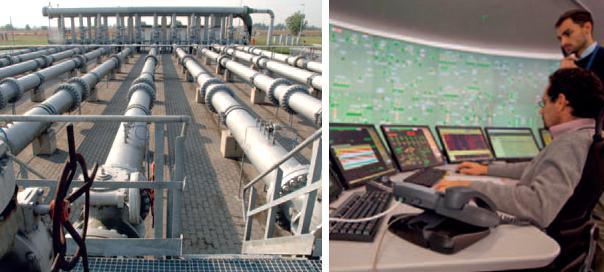Being on-site where energy is conveying, this is common practice for BARTEC. For 40 years, the brand has been synonymous with safety in areas subject to explosion hazards. In a current project, the leading global provider of explosion protection is ensuring the quality of Italy’s most important energy resource whilst it is being transported.
At 64.4 per cent of the energy mix, natural gas is the country’s most important source of energy for electricity generation, increasingly taking over from oil. This makes Italy one of Europe’s biggest consumers of natural gas. All the more vital then that the gas gets to where it is needed in perfect condition. This has been the task for Snam Rete Gas, Italy’s largest gas transporter, for over 70 years. The pipeline network stretches for 32,000 kilometres up and down the Italian “boot”.
The gas, from Russia, northern Europe and northern Africa, is conveyed by Snam Rete Gas to local distribution networks, industrial bulk buyers and power stations. Snam Rete Gas’ distribution centre in Milan works around the clock to ensure that the gas is available everywhere at all times in the required quantity and quality. The team focuses particularly on quality factors such as the dew point. This is the temperature at which dew forms.
To explain: water vapour precipitates as mist or dew droplets when the ambient temperature is equal to or below the dew point. The lower the water dew point, the smaller the quantity of water vapour in the gas. The lower the hydrocarbon dew point, the smaller the quantity of heavy hydrocarbons. Both must be available in order to achieve high gas quality. In addition, high dew point values are a potential risk factor for every natural gas facility. This is why they require constant monitoring by Snam Rete Gas. This is where BARTEC comes in.
Snam Rete Gas uses a combined dew point measuring device for water and hydrocarbons from BARTEC BENKE. The product, called HYGROPHIL HCDT, is suitable for use in explosive areas and has become standard equipment for natural gas suppliers. The two measurements are covered by one device, which both lowers costs and increases efficiency. The sensor contains a miniature chilled mirror. The special surface is systematically heated and cooled. The reflectivity, which changes as the result of the buildup of condensation, is measured subject to the temperature.
This results in a high level of precision of +/- 0.5 °C, making it a highly reliable indicator for natural gas quality. Together with a sample preparation and optical sensors, the HYGROPHIL HCDT not only minimizes the recalibration workload due to the virtually drift-free measurement, but also removes the need for intensive cleaning work, as the contaminations carried in the gas do not affect the measurement. The hydrocarbon dew point sensor’s very low detection limit allows it to detect the buildup of condensation early. The instruments therefore make an active contribution to quality assurance.
After all, only when the measurements are consistently precise can the status in the gas grid be correctly checked and recorded and the quality of the gas proven and maintained at a high level. As a gas transporter, Snam Rete Gas must ensure three things every day: gas quality, facility protection and cost reduction. BARTEC helps to achieve these goals as efficiently as possible.

